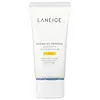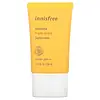What's inside
What's inside
 Key Ingredients
Key Ingredients

 Benefits
Benefits

 Concerns
Concerns

 Ingredients Side-by-side
Ingredients Side-by-side

Butyl Methoxydibenzoylmethane 2.5%
UV AbsorberHomosalate 9%
Skin ConditioningOctocrylene 9%
UV AbsorberEthylhexyl Salicylate 4.5%
UV AbsorberWater
Skin ConditioningPropanediol
SolventButyloctyl Salicylate
Skin ConditioningGlycerin
HumectantDimethicone
EmollientSilica
AbrasiveDiphenylsiloxy Phenyl Trimethicone
Skin ConditioningBehenyl Alcohol
EmollientTrisiloxane
Skin ConditioningVp/Eicosene Copolymer
Cyclopentasiloxane
EmollientTrimethylsiloxysilicate
EmollientC14-22 Alcohols
Emulsion StabilisingCeramide AP
Skin Conditioning1,2-Hexanediol
Skin ConditioningGlyceryl Stearate
EmollientPEG-100 Stearate
Phenyl Trimethicone
Skin ConditioningCetyl Alcohol
EmollientPotassium Cetyl Phosphate
EmulsifyingCaprylyl Methicone
Skin ConditioningPolyacrylate-13
Parfum
MaskingPolyisobutene
C12-20 Alkyl Glucoside
EmulsifyingEthylhexylglycerin
Skin ConditioningDisodium EDTA
Polysorbate 20
EmulsifyingSorbitan Isostearate
EmulsifyingLavandula Angustifolia Flower Water
Skin ConditioningButylphenyl Methylpropional
PerfumingHydroxycitronellal
PerfumingLimonene
PerfumingBenzyl Salicylate
PerfumingAlpha-Isomethyl Ionone
PerfumingGeraniol
PerfumingCitronellol
PerfumingButylene Glycol
HumectantGlucose
HumectantAloe Barbadensis Leaf Extract
EmollientPentylene Glycol
Skin ConditioningCentella Asiatica Flower/Leaf/Stem Extract
Skin ConditioningBrassica Oleracea Italica Extract
AstringentHibiscus Abelmoschus Extract
MaskingMagnesium Sulfate
Calcium Chloride
AstringentTocopherol
AntioxidantXanthan Gum
EmulsifyingCitric Acid
BufferingSodium Benzoate
MaskingPotassium Sorbate
PreservativeManganese Sulfate
Skin ConditioningChenopodium Quinoa Seed Extract
Skin ConditioningZinc Sulfate
AntimicrobialAscorbyl Glucoside
AntioxidantButyl Methoxydibenzoylmethane 2.5%, Homosalate 9%, Octocrylene 9%, Ethylhexyl Salicylate 4.5%, Water, Propanediol, Butyloctyl Salicylate, Glycerin, Dimethicone, Silica, Diphenylsiloxy Phenyl Trimethicone, Behenyl Alcohol, Trisiloxane, Vp/Eicosene Copolymer, Cyclopentasiloxane, Trimethylsiloxysilicate, C14-22 Alcohols, Ceramide AP, 1,2-Hexanediol, Glyceryl Stearate, PEG-100 Stearate, Phenyl Trimethicone, Cetyl Alcohol, Potassium Cetyl Phosphate, Caprylyl Methicone, Polyacrylate-13, Parfum, Polyisobutene, C12-20 Alkyl Glucoside, Ethylhexylglycerin, Disodium EDTA, Polysorbate 20, Sorbitan Isostearate, Lavandula Angustifolia Flower Water, Butylphenyl Methylpropional, Hydroxycitronellal, Limonene, Benzyl Salicylate, Alpha-Isomethyl Ionone, Geraniol, Citronellol, Butylene Glycol, Glucose, Aloe Barbadensis Leaf Extract, Pentylene Glycol, Centella Asiatica Flower/Leaf/Stem Extract, Brassica Oleracea Italica Extract, Hibiscus Abelmoschus Extract, Magnesium Sulfate, Calcium Chloride, Tocopherol, Xanthan Gum, Citric Acid, Sodium Benzoate, Potassium Sorbate, Manganese Sulfate, Chenopodium Quinoa Seed Extract, Zinc Sulfate, Ascorbyl Glucoside
Water
Skin ConditioningPropylheptyl Caprylate
EmollientTitanium Dioxide
Cosmetic ColorantZinc Oxide
Cosmetic ColorantCyclohexasiloxane
EmollientButylene Glycol Dicaprylate/Dicaprate
EmollientDisiloxane
Skin ConditioningButylene Glycol
HumectantPolyglyceryl-5 Polyricinoleate
EmulsifyingPolymethylsilsesquioxane
Glycerin
HumectantCaprylyl Methicone
Skin ConditioningDicaprylyl Ether
EmollientNiacinamide
SmoothingDisteardimonium Hectorite
StabilisingPolyglyceryl-3 Polydimethylsiloxyethyl Dimethicone
Skin ConditioningCalcium Aluminum Borosilicate
Magnesium Sulfate
1,2-Hexanediol
Skin ConditioningTriethoxycaprylylsilane
Octyldodecanol
EmollientParfum
MaskingDicaprylyl Carbonate
EmollientCI 77492
Cosmetic ColorantCaprylyl Glycol
EmollientGlyceryl Caprylate
EmollientMica
Cosmetic ColorantEthylhexylglycerin
Skin ConditioningAluminum Hydroxide
EmollientAdenosine
Skin ConditioningCI 77491
Cosmetic ColorantEchium Plantagineum Seed Oil
Skin ConditioningBoron Nitride
AbsorbentSodium Hyaluronate
HumectantPropylene Glycol Dicaprylate/Dicaprate
EmollientSaccharide Isomerate
HumectantPropanediol
SolventCI 77499
Cosmetic ColorantTocopherol
AntioxidantHelianthus Annuus Seed Oil Unsaponifiables
EmollientCardiospermum Halicacabum Flower/Leaf/Vine Extract
Skin ConditioningDimethicone/Vinyl Dimethicone Crosspolymer
Skin ConditioningOryza Sativa Bran Oil
EmollientLespedeza Capitata Leaf/Stem Extract
Skin ConditioningSodium Citrate
BufferingCitric Acid
BufferingWater, Propylheptyl Caprylate, Titanium Dioxide, Zinc Oxide, Cyclohexasiloxane, Butylene Glycol Dicaprylate/Dicaprate, Disiloxane, Butylene Glycol, Polyglyceryl-5 Polyricinoleate, Polymethylsilsesquioxane, Glycerin, Caprylyl Methicone, Dicaprylyl Ether, Niacinamide, Disteardimonium Hectorite, Polyglyceryl-3 Polydimethylsiloxyethyl Dimethicone, Calcium Aluminum Borosilicate, Magnesium Sulfate, 1,2-Hexanediol, Triethoxycaprylylsilane, Octyldodecanol, Parfum, Dicaprylyl Carbonate, CI 77492, Caprylyl Glycol, Glyceryl Caprylate, Mica, Ethylhexylglycerin, Aluminum Hydroxide, Adenosine, CI 77491, Echium Plantagineum Seed Oil, Boron Nitride, Sodium Hyaluronate, Propylene Glycol Dicaprylate/Dicaprate, Saccharide Isomerate, Propanediol, CI 77499, Tocopherol, Helianthus Annuus Seed Oil Unsaponifiables, Cardiospermum Halicacabum Flower/Leaf/Vine Extract, Dimethicone/Vinyl Dimethicone Crosspolymer, Oryza Sativa Bran Oil, Lespedeza Capitata Leaf/Stem Extract, Sodium Citrate, Citric Acid
 Reviews
Reviews

Ingredients Explained
These ingredients are found in both products.
Ingredients higher up in an ingredient list are typically present in a larger amount.
1,2-Hexanediol is a synthetic liquid and another multi-functional powerhouse.
It is a:
- Humectant, drawing moisture into the skin
- Emollient, helping to soften skin
- Solvent, dispersing and stabilizing formulas
- Preservative booster, enhancing the antimicrobial activity of other preservatives
Butylene Glycol (or BG) is used within cosmetic products for a few different reasons:
Overall, Butylene Glycol is a safe and well-rounded ingredient that works well with other ingredients.
Though this ingredient works well with most skin types, some people with sensitive skin may experience a reaction such as allergic rashes, closed comedones, or itchiness.
Learn more about Butylene GlycolCaprylyl Methicone is a type of silicone.
It helps soften and soothe the skin by creating a thin film on top. This film helps trap moisture, keeping your skin hydrated.
Citric Acid is an alpha hydroxy acid (AHA) naturally found in citrus fruits like oranges, lemons, and limes.
Like other AHAs, citric acid can exfoliate skin by breaking down the bonds that hold dead skin cells together. This helps reveal smoother and brighter skin underneath.
However, this exfoliating effect only happens at high concentrations (20%) which can be hard to find in cosmetic products.
Due to this, citric acid is usually included in small amounts as a pH adjuster. This helps keep products slightly more acidic and compatible with skin's natural pH.
In skincare formulas, citric acid can:
While it can provide some skin benefits, research shows lactic acid and glycolic acid are generally more effective and less irritating exfoliants.
Most citric acid used in skincare today is made by fermenting sugars (usually from molasses). This synthetic version is identical to the natural citrus form but easier to stabilize and use in formulations.
Read more about some other popular AHA's here:
Learn more about Citric AcidEthylhexylglycerin (we can't pronounce this either) is commonly used as a preservative and skin softener. It is derived from glyceryl.
You might see Ethylhexylglycerin often paired with other preservatives such as phenoxyethanol. Ethylhexylglycerin has been found to increase the effectiveness of these other preservatives.
Glycerin is already naturally found in your skin. It helps moisturize and protect your skin.
A study from 2016 found glycerin to be more effective as a humectant than AHAs and hyaluronic acid.
As a humectant, it helps the skin stay hydrated by pulling moisture to your skin. The low molecular weight of glycerin allows it to pull moisture into the deeper layers of your skin.
Hydrated skin improves your skin barrier; Your skin barrier helps protect against irritants and bacteria.
Glycerin has also been found to have antimicrobial and antiviral properties. Due to these properties, glycerin is often used in wound and burn treatments.
In cosmetics, glycerin is usually derived from plants such as soybean or palm. However, it can also be sourced from animals, such as tallow or animal fat.
This ingredient is organic, colorless, odorless, and non-toxic.
Glycerin is the name for this ingredient in American English. British English uses Glycerol/Glycerine.
Learn more about GlycerinMagnesium Sulfate is a salt. More specifically, it is an epsom salt, or the bath salt used to help relieve muscle aches.
Despite having ‘sulfate’ in the name, it isn’t a surfactant or cleansing agent like sodium lauryl sulfate. Unlike those sulfates, magnesium sulfate doesn’t have the same cleansing or foaming properties (it's simply a type of salt).
In cosmetics, Magnesium Sulfate is used to thicken a product or help dilute other solids. It is a non-reactive and non-irritating ingredient.
One study shows magnesium deficiency may lead to inflammation of the skin. Applying magnesium topically may help reduce inflammation.
You can find this ingredient in sea water or mineral deposits.
Learn more about Magnesium SulfateParfum is a catch-all term for an ingredient or more that is used to give a scent to products.
Also called "fragrance", this ingredient can be a blend of hundreds of chemicals or plant oils. This means every product with "fragrance" or "parfum" in the ingredients list is a different mixture.
For instance, Habanolide is a proprietary trade name for a specific aroma chemical. When used as a fragrance ingredient in cosmetics, most aroma chemicals fall under the broad labeling category of “FRAGRANCE” or “PARFUM” according to EU and US regulations.
The term 'parfum' or 'fragrance' is not regulated in many countries. In many cases, it is up to the brand to define this term.
For instance, many brands choose to label themselves as "fragrance-free" because they are not using synthetic fragrances. However, their products may still contain ingredients such as essential oils that are considered a fragrance by INCI standards.
One example is Calendula flower extract. Calendula is an essential oil that still imparts a scent or 'fragrance'.
Depending on the blend, the ingredients in the mixture can cause allergies and sensitivities on the skin. Some ingredients that are known EU allergens include linalool and citronellol.
Parfum can also be used to mask or cover an unpleasant scent.
The bottom line is: not all fragrances/parfum/ingredients are created equally. If you are worried about fragrances, we recommend taking a closer look at an ingredient. And of course, we always recommend speaking with a professional.
Learn more about ParfumPropanediol is an all-star ingredient. It softens, hydrates, and smooths the skin.
It’s often used to:
Propanediol is not likely to cause sensitivity and considered safe to use. It is derived from corn or petroleum with a clear color and no scent.
Learn more about PropanediolTocopherol (also known as Vitamin E) is a common antioxidant used to help protect the skin from free-radicals and strengthen the skin barrier. It's also fat soluble - this means our skin is great at absorbing it.
Vitamin E also helps keep your natural skin lipids healthy. Your lipid skin barrier naturally consists of lipids, ceramides, and fatty acids. Vitamin E offers extra protection for your skin’s lipid barrier, keeping your skin healthy and nourished.
Another benefit is a bit of UV protection. Vitamin E helps reduce the damage caused by UVB rays. (It should not replace your sunscreen). Combining it with Vitamin C can decrease sunburned cells and hyperpigmentation after UV exposure.
You might have noticed Vitamin E + C often paired together. This is because it is great at stabilizing Vitamin C. Using the two together helps increase the effectiveness of both ingredients.
There are often claims that Vitamin E can reduce/prevent scarring, but these claims haven't been confirmed by scientific research.
Learn more about TocopherolWater. It's the most common cosmetic ingredient of all. You'll usually see it at the top of ingredient lists, meaning that it makes up the largest part of the product.
So why is it so popular? Water most often acts as a solvent - this means that it helps dissolve other ingredients into the formulation.
You'll also recognize water as that liquid we all need to stay alive. If you see this, drink a glass of water. Stay hydrated!
Learn more about Water